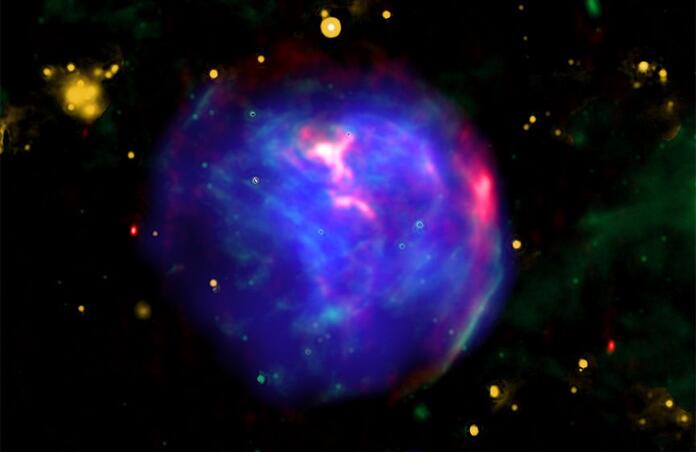From reverse shockwaves to your jewellery - the beauty of supernova remnants

Colourful supernova remnants and their white dwarf stars help shed light on some even more massive and mysterious objects.
The supernova G344.7-0.1 is believed to have occurred some 3000 to 6000 years ago (although it is located some 19 600 light-years away from Earth which means it actually happened about 25 000 years ago but we’re only receiving the light now). Note that most of the stars in our Universe are found in binary systems: for G344.7-0.1, we had a white dwarf feeding from the material of its companion, which means it was a Type Ia supernova. As a reminder, this is when the white dwarf eventually accretes too much material to remain stable and explodes. The new image, a composite between X-ray, infrared, radio and visible data, emerges from a collaboration between NASA's Chandra X-ray Observatory and Spitzer Space Telescope, the National Science Foundation's Very Large Array and the Australia Telescope Compact Array.
After the supernova explosion, gases from the star get expanded outwards. From this new image, astronomers figure that these debris eventually encounter enough resistance from surrounding gas particles for the shock wave to be reversed. As that travels back towards the epicentre of the initial explosion, the gas still inside the supernova bubble gets heated up – this is where Chandra comes in, as the emissions are in the X-ray regime. In most of the supernovas of this type that we can observe, the shock wave hasn’t yet reversed all the way back, which makes this set of observations an incredible opportunity. It enabled the researchers to trace the elements found in almost all of this remnant, confirming the predictions that iron is produced closest to the centre of the explosion whereas lighter elements like, e.g., silicon, appear in arc-like structures further out from that centre.

Another target recently observed by Chandra is Cassiopeia A, the supernova remnant from a much more massive star’s explosion. Like in the previous space bubble, oxygen and iron have been detected (represented in purple and orange in the image above respectively). However, on top of that, the blue blobs are globules of titanium, an element not found in small mass stars’ “leftovers”. This gives astronomers clues about the deaths of more massive stars and about the processes leading to the formation of the heavier elements of the periodic table – elements we all love, as titanium is used in electronics and jewellery for example.

the illustration hints at the presence of magnetic field lines in blue
Back to our small stars though, NASA’s Transiting Exoplanet Survey Satellite (TESS) has been employed to look at the TW Pictoris system, another binary system. Typically, a white dwarf appears to decrease in brightness and then goes back to its normal luminosity over the course of a few days, sometimes months; from the TESS data though, astronomers found that the one in TW Pictoris loses brightness in 30 minutes. The best explanation for this phenomenon is that there is interference in the “feeding” process. More precisely, the researchers from Durham University suggest that the white dwarf’s surface magnetic field gets reconfigured, effectively leading to alternating periods of normal accretion and magnetic phasing phases. In the latter, the spinning magnetic field of the white dwarf reduces the amount of material by forcing it to pass through what can be described as a magnetic gate.
This magnetic switching on and off of white dwarfs could be a very frequent process, including in neutron stars. But, since white dwarfs are much more common, they’re easier to observe and understand, which lays the foundations for researchers tackling their extremely dense counterparts, or for those studying the death of more massive stars as with Cassiopeia A.
Cover Image: Supernova remnant G344.7-0.1, X-ray: NASA/CXC/Tokyo Univ. of Science/K. Fukushima, et al.; IR: NASA/JPL/Spitzer; Radio: CSIRO/ATNF/ATCA
Image Credits:
1 - Figure 2 from "Element Stratification in the Middle-aged SN Ia Remnant G344.7–0.1", Fukushima et al., 2020
2 - Cassiopeia A, NASA/CXC/RIKEN/T. SATO ET AL.; NUSTAR: NASA/NUSTAR
3 - Artist's impression of accreeting White Dwarf, H. Uthas
